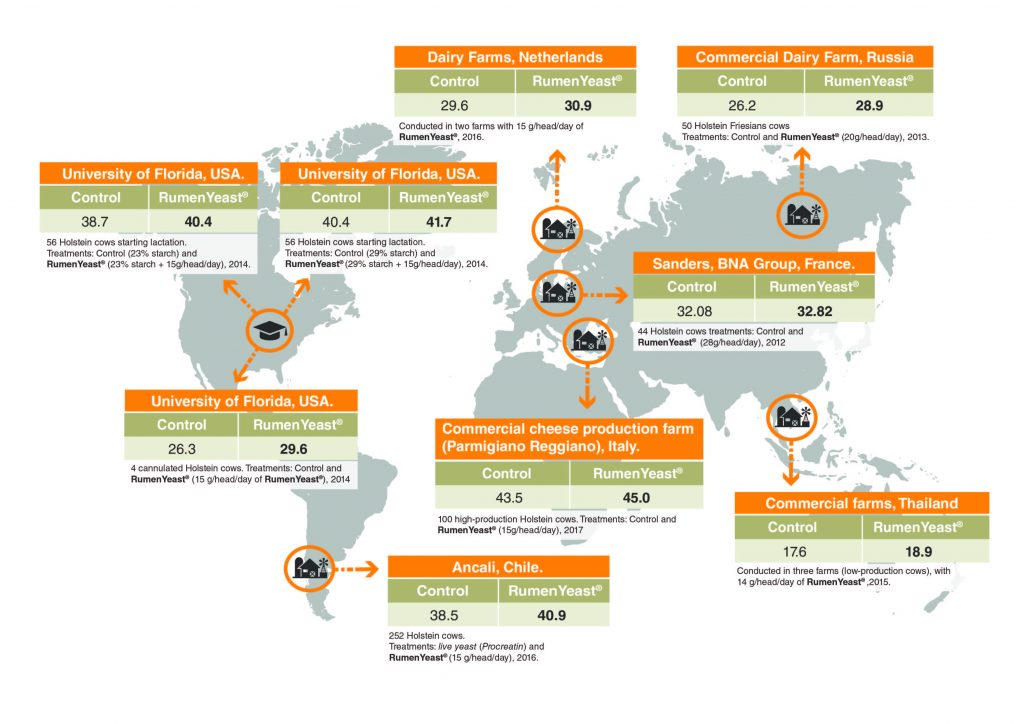Melina Bonato and Liliana Borges (R&D department, ICC Brazil)
The dairy production goal is to have healthy animals that can achieve the maximum genetic potential production at less cost. The animal health is related to diseases caused by a pathogen agent, metabolic/nutritional/reproductive/physical problems and stress factors (environmental conditions, handling, etc.). When talking about ruminants, besides thinking about the improvement of the animal nutrition, we must think about the rumen nutrition and health, considering that well-nourished, healthy and properly stimulated rumen flora provides better productivity rates, associated to better animal health. In this context, the use of functional ingredients that provide gains in performance and improvement in animal health tend to become required items in the diet of dairy cattle.
The yeast has been widely used in ruminant’s nutrition as a functional feed additive, and there is extensive literature proven its benefits. The RumenYeast® (ICC Brazil Company) is pure Saccharomyces cerevisiae yeast originating from sugarcane fermentation process for ethanol production, undergoes through autolysis (cell membrane disruption) where the intracellular content is released. The final product is highly digestible because also contains amino acids, peptides, and polypeptides of short chain, glutamic acid, and the presence of the yeast cell wall, mainly composed by mannan oligosaccharides (MOS) and high levels of β-glucans.
The β-glucans are known as immune system modulators or stimulants. They are natural and effective stimulants of the innate immune system and when they come in contact with the phagocytic cells, which recognize the β-1,3 and 1,6 bindings (Petravic-Tominac et al., 2010), these cells are stimulated and produces some cytokines that start a chain reaction inducing an immunomodulation and improving the response capacity of the innate immune system. Another benefit of using β-glucans is the mycotoxins binding capacity, by hydrogen bonds and by van der Waals bonds, this mode of action guarantees a wide range of adsorption on different mycotoxins. The most of the adsorbents present in the world market are based on aluminosilicates, which are highly efficient in the adsorption of polar mycotoxins (such as aflatoxin) but also can bind to vitamins and minerals of the diet. Differently, β-glucans do not bind to vitamins and minerals, and still to have greater surface area than aluminosilicates, providing better efficiency.
MOS, as mentioned above, are also structural components of the yeast cell wall, and are known for their pathogens (that has type 1 fimbria) agglutination capacity, such as diverse Salmonella and Escherichia coli strains. MOS offers a binding site for pathogens, preventing the colonization of the intestinal epithelium, and these agglutinated bacteria will be excreted together with the indigestible part of the fiber.
Thus yeast cell wall supplementation with a high concentration of MOS and β-glucans can be associated to decrease of contamination of some pathogens and immune system modulation. This type of response is especially important in animals in initial growth and reproductive phases, stress periods, environmental challenges, and even improving response to immunosuppressive diseases; acting as a prophylactic agent and increasing animal resistance, minimizing further damages (such as a drop in performance or high mortality rates).
Beyond the intestinal health, which will reflect on general animal health, the rumen flora must be considered as a complex factor in all dairy cow responses. Modulate and support the rumen flora to speed up the digestion of cellulose and hemicellulose, stabilize the rumen pH under conditions of feed or caloric stress, and increase the production of volatile fatty acids (Dias et al., 2017a,b) are the benefits expected with RumenYeast® supplementation.
In the current context of the international dairy market, increasing milk production regarding quantity is, sometimes, no longer relevant due to low prices. Now more than ever, producing more milk fat and protein is a proven way to enhance herd profitability. The best way to boost milk fat and protein is to promote rumen fermentation with a particular focus on fiber digestion.
It is important to notice that fat found in the milk originates from three sources: de novo fatty acids synthesized in the milk gland of the cow (short-chain C4 to C14) that comprise about 20-30% of total milk fatty acids, preformed fatty acids (long chain C18:0, C18:1 and C18:3) which represent 35-40% and the mixed group of fatty acids (C16) making up about 35%. The literature has shown that the percentage of milk de novo fatty acids is positively correlated with the percentage of fat and true protein in the milk. It has also been indicated that this short chain fatty acids explain nearly 50% of the variation in milk fat percentage and as much as 68% of the variation in milk true protein. De novo fatty acids are crucial and can be used to monitor herd management. Indeed, milk fat and protein are two key drivers of dairy profitability positively related to net milk income over feed costs. The quantity of de novo fatty acids reflects rumen functioning, especially fiber fermentation which produces acetate and butyrate, the building blocks of fatty acids. The relative proportion of de novo fatty acids in milk fat reflects how well the cow is being fed and managed for optimal rumen fermentation. Higher de novo fatty acids in the milk reflect healthier rumen conditions (Blezinger and Bonato, 2017).
The intrinsic digestibility of the forage fiber is a function of plant genetics, maturity at harvest and growing environment; which determine the amount of lignin. Rumen pH has a large impact on the fiber fermentation. Thus, poor feeding management can influence rumen pH and subsequent fiber digestion and microbial protein production. Furthermore, recent researches have shown that feeding or management practices reducing pH results in accumulation of CLA isomer that has a powerful milk fat depressing effect. Some management practices can enhance rumen conditions as to avoid overstock pens, feed more frequently, balanced diet with properly fat and fiber requirements (and proper levels of physically effective NDF), and the use of feed additives/components to support rumen fermentation.
Several studies have been showed (Dias et al., 2017a,b) that RumenYeast® can increase the milk production by +2 kg/cow/day, in research trials and field trials (Table 1) and milk quality (fat and protein), decrease SCC and diseases incidence, and also the mycotoxin contamination in the milk (Gonçalves et al., 2017).
Table 1. Increased milk production in cows fed diets supplemented with RumenYeast® worldwide.

The combination of proper rumen nutrition with the strengthening of the animals’ immune system means higher daily milk production, besides reducing to zero the concerns about any residues in the milk, a key factor to conquer an increasingly demanding consumer market.
References
Blezinger S.B. and Bonato, M.A. Optimising milk fat strengthens dairy profits. All about feed, feed additives, June 2017.
Dias et al. 2017 (a). Effects of supplementing yeast culture to diets differing in starch content on performance and feeding behavior of dairy cows. J. Dairy Sci. 101:1–15.
Dias et al. 2017 (b). Effect of supplemental yeast culture and dietary starch content on rumen fermentation and digestion in dairy cows. J. Dairy Sci. 101:1–21.
Gonçalves, B.L., et al., 2017. Effects of different sources of Saccharomyces cerevisiae biomass on milk production, composition, and aflatoxin M1excretion in milk from dairy cows fed aflatoxin B1. Journal of Dairy Science, 100 (7): 5701–5708.
Petravić-Tominac, V. et al., 2010. Biological effects of yeast β-glucans. Agriculturae Conspectus Scientificus, 75 (4).
发布于: 11 十月 of 2018


